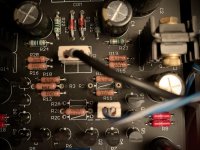@lumlum
The build looks very nice. The issue is in both channels so it is a systematic error.
The first thing to check after confirming the power supply voltages is the output bias currents.
You'll need to measure the voltage drop across R17 and R18, and compute the current as I = V/R.
It's possible you mixed up the transistors, so the circuit is not providing amplification. Or it's possible you mixed up resistor values, so the circuit gain is less than expected.
I note you are running in open loop mode, using R3. What is the value of R3 and R2, and what headphones are you using?
The build looks very nice. The issue is in both channels so it is a systematic error.
The first thing to check after confirming the power supply voltages is the output bias currents.
You'll need to measure the voltage drop across R17 and R18, and compute the current as I = V/R.
It's possible you mixed up the transistors, so the circuit is not providing amplification. Or it's possible you mixed up resistor values, so the circuit gain is less than expected.
I note you are running in open loop mode, using R3. What is the value of R3 and R2, and what headphones are you using?











